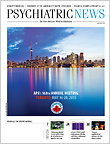The new DSM-5 guide for laypersons, Understanding Mental Disorders: Your Guide to DSM-5, which will be published by American Psychiatric Publishing in May, appears to be a unique publication.
“There’s really nothing like it on the market, certainly nothing quite as comprehensive,” said psychiatrist Donald Black, M.D., vice chair for education in the Department of Psychiatry at the University of Iowa Roy J. and Lucille A. Carver College of Medicine and one of the six editorial advisers for the new book. “There are other books for the public about various disorders, but none that covers DSM-5 in its entirety. And many of the books on the market are not authoritative or are written in a style that is not really accessible to the average reader.”
Understanding Mental Disorders: Your Guide to DSM-5 is intended for patients and their families, but also for other members of the public with an interest in psychiatric illness and how it might be affecting the people around them or for whom they are responsible—teachers, administrators, coaches, employers, and clergy, among others will find it useful. A first draft was written by a professional medical writer, with each chapter being rigorously reviewed, edited, and revised by the advisory panel (for a list of the panel members, see
Psychiatric News, February 6).
“The new book introduces the public to
DSM-5 and its organization in a language that is accessible to the layperson,” Black told
Psychiatric News. (To listen to an audio interview with Donald Black, M.D., click
here).
Mirroring the clinician’s version released in 2013, the new guide is arranged roughly along developmental lines, reflecting a “lifespan” approach to mental illness. Hence, the first chapter is “Disorders That Start in Childhood,” followed by “Schizophrenia and Other Psychotic Disorders” and “Bipolar Disorders” (
Psychiatric News, February 6).
The fourth, fifth, and sixth chapters of the new book are on depressive disorders, anxiety disorders, and obsessive-compulsive disorders. The opening paragraph of the chapter on depressive disorders offers a glimpse of the straightforward way in which the book distinguishes ordinary sadness from the disorder known as depression:
“In everyday life, the word ‘depression’ or ‘depressed’ is often used to express when someone is unhappy or sad for a moment. For example, people might say ‘I’m depressed’ when they feel let down that their sports team lost a game. In contrast, real depression is a major medical problem that can have a deep and profound impact on a person’s safety and well-being. Depressive disorders share the common feature of causing a person to feel sad, empty, or irritable (easily annoyed or in a bad mood).
“Someone with depression may have trouble sleeping, thinking, or doing once-normal daily functions. The disorders in this group differ in how long symptoms last, when they arise, and their causes.”
The chapter covers major depressive disorder, persistent depressive disorder, premenstrual dysphoric disorder, and disruptive mood dysregulation disorder. Each disease section includes not only a description of the disorder but a variety of user-friendly features—tips for medication use, ways to cope with the disorder, and what to expect when seeking psychiatric treatment. And each chapter includes an illustrative patient story drawn from actual patient experiences but with names and other identifying information changed.
For instance, in the section on premenstrual dysphoric disorder (PMDD), under a feature titled “A Healthy Body and Mind,” the manual notes that “during treatment, changes in lifestyle may help relieve symptoms.” And it offers the following common-sense ways a patient can improve her chances of recovery:
•
Eat healthy. Making diet changes to reduce the intake of caffeine, salt, and sugar may help relieve symptoms.
•
Try over-the-counter relief. Pain relievers such as aspirin and ibuprofen may help ease breast tenderness, backache, and cramping. Diuretics, or water pills, can help with bloating.
•
Exercise. Although it’s unclear whether exercise can relieve more severe symptoms of PMDD (and it may be hard to exercise when symptoms are at their worst), regular aerobic exercise—such as walking or bicycling—can help ease fatigue, boost mood, and improve sleep.
•
Keep a diary. Writing down the type of symptoms and their severity and duration can help health care providers diagnose the disorder and choose the best treatment.
Similarly, the chapter on anxiety disorders notes that these illnesses differ from normal feelings of being worried, ill at ease, or afraid. “People with these disorders have extreme fear or worry that impairs their life function and goes beyond what is normal for their age or the setting,” the guide states.
The chapter covers panic disorder, agoraphobia, generalized anxiety disorder, specific phobia, social anxiety disorder, and separation anxiety disorder.
Obsessive-compulsive disorders (OCD), according to the manual, “involve frequent fears, worries, urges, or thoughts (obsessions) that distract and distress the people who have them. These obsessions often are combined with ritualistic behaviors (compulsions) that are repeated in an intense attempt to deal with the unwanted obsessions.”
The chapter covers OCD, body dysmorphic disorder, hoarding disorder, hair-pulling disorder, and skin-picking disorder. Also, it notes that DSM-5 marks a departure from previous editions of DSM by separating the OCDs from the anxiety disorders.
Black, who has had a career-long research and clinical interest in OCD, explained why. “Research over the last 20 years has shown that the disorders now grouped within this chapter appear to be related genetically and neurobiologically,” he said. “This is research from family and follow-up studies that has demonstrated how these disorders group within families, produce similar kinds of changes in the brain, and respond in similar ways to similar treatments.” ■
More information on
Understanding Mental Disorders, including pre-ordering information and links to previous articles in
Psychiatric News about the content, can be accessed
here.

